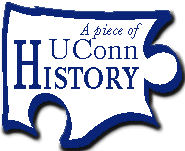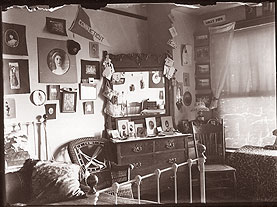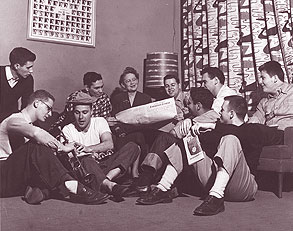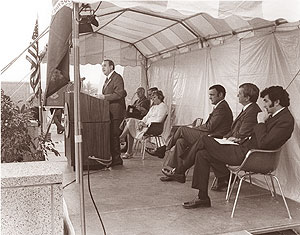This is an archived article.
For the latest news, go to the
Advance Homepage For more archives, go to the Advance Archive/Search Page. 
| ||||||||
|
1880: Two Connecticut-born businessmen from New York - brothers Augustus and Charles Storrs - offered a gift to the State of Connecticut to establish an agricultural school for boys. The Storrs Agricultural School was officially created through legislation passed on April 21, 1881.
1890: Two wooden frame buildings are constructed on the campus of the school: Gold Hall, a two-story men's dormitory, named for Theodore S. Gold, a trustee; and a building known as Old Main, that housed administrative offices, classrooms and laboratories, the library, bookstore, museum of natural history, study halls, faculty apartments, and the dining hall. A wood-frame building that housed women, Grove Cottage, would be built in 1895. 1900: The first brick building on campus was constructed along the state road that would become known as Route 195. Called Agricultural Hall, it was located on the east side of the road, across from where the Floriculture Building is situated today. Also in 1900, the term "Aggies" was first used to describe players on the athletic teams. Organized athletics had begun around 1896.
1905: The executive committee of the Connecticut Grange, a then-powerful political and social organization for farmers, reported that Connecticut Agricultural College - as it had become known in 1899 - was worthy of continued support. A bill was presented to the legislature later that year for the construction of Storrs Hall, the first brick dormitory. Also in 1905, a barber opened "tonsorial parlors" at Four Corners, and students no longer had to walk to Willimantic or Coventry for haircuts. 1910: The Mechanic Arts Building on North Eagleville Road was completed, but funding was insufficient and it opened first as a temporary dining hall. In 1911, Mechanic Arts became a two-year program that included wood-working, pattern-making, forging, shop work and mechanical drafting courses. It later became the School of Engineering. Also in 1910, arrangements were made with the Willimantic Gas and Electric Company to extend their lines to the college campus. Storrs Hall and Horticultural Hall (later named Gulley Hall), and residential cottages for faculty and administrators, were wired for electricity when built. 1915: For the first time in its history, the college awarded regular degrees. Previously degrees were granted occasionally, with most graduates receiving certificates for completion of programs. Curriculum changes in 1911 established degree programs, and in 1914 a high school diploma was required for admission to CAC. Also in 1915, researchers at the Storrs Agricultural Experiment Station, working to reduce the high mortality in chicks caused by the bacterial infection Pullorium, identified the cause and designed a system of control that proved essential to the modern poultry industry. The first Nutmeg Yearbook was published in 1915. 1920: A Committee on Graduate Study was formed, whose work eventually led to the creation of a Division of Graduate Study, that in 1940 became the Graduate School. Also in 1920, the first master's degree was awarded to Domingo Paguirigan, a student from the Philippines. And a new Dining Hall opened, affectionately known to students as "the Beanery," for its cafeteria-style menu that invariably included beans. The building is now the home of the William Benton Museum of Art. 1925: The General Assembly limited enrollment to 500 students, with preference given to students taking the four-year agriculture program. Gov. Hiram Bingham told legislators the college should become "an exceptionally effective agricultural college rather than an institution of general education." Faculty took advantage of the limits to raise entrance standards. By the late 1930s, however, enrollment was more than 1,000 and in 1939 trustees gained the authority to set enrollment. 1930: Charles C. McCracken, former professor of school administration at Ohio State University, became the sixth president of the college, replacing George A. Works who resigned after one year in office. Also in 1930, faculty qualifications were stipulated: an instructor was required to have at least one year of graduate study; an assistant professor had to have a master's degree or the equivalent, and a full professor had to have a doctoral degree. Following an outbreak of polio, the State Board of Finance and Control granted an emergency appropriation to hire a resident part-time physician for the college. 1935: This eventful year saw the arrival of the first campus mascot, hot debate on issues of free speech, and the resignation of one president and hiring of another. 1940: In its second year as the University of Connecticut, schools and colleges were established from what had been divisions of the college. The first established were: the Colleges of Agriculture, and Arts and Sciences; the Schools of Education, Engineering, and Home Economics; and the Graduate School. The School of Social Work was created as well. 1945: The Veteran's Administration requested that the University admit 3,000 to 4,000 returning veterans. Temporary housing was built the next year and regional campus programs were started in Hartford, Waterbury and Fort Trumbull in New London.
1950: The regional campus at Fort Trumbull in New London, open since 1946 in a former Merchant Marine training facility, closed. It was used to handle the overflow of former G.I.s who went to college following World War II. The all-male campus of freshmen and sophomores was UConn's only regional campus to include on-campus housing for students. 1955: A daily newspaper since 1953, The Connecticut Daily Campus became a morning newspaper in 1955. Since its beginnings in 1896 as a monthly, The Lookout, and later as The Connecticut Campus, the paper had been published in the afternoon. Its name was shortened to The Daily Campus in 1991. Also in 1955, the University Auditorium opened with a concert by the Boston Symphony Orchestra. The building was later named for Albert N. Jorgensen, president from 1935 to 1962. 1960: A silver anniversary convocation was held to mark Albert Jorgensen's 25 years as president. Disputes with younger faculty and weakening influence with the legislature led to his retirement two years later. Also in 1960, the School of Fine Arts was established. 1965: The North Campus quadrangle was established as a freshmen-only male residence complex, in hopes of reducing the freshman drop-out rate. Study rooms were added to the dormitories and McConaughy was reserved as a freshmen-only dining hall. Also in 1965, the Honors Program was established. When a major power-outage in November left the campus without power for 15 hours, President Homer Babbidge called in a band to organize a dance to quell an increasingly restless student body. The same year, a campus-wide march was held to demonstrate concern over violence against civil rights advocates in Selma, Ala. 1970: Arising from continued protests against the war in Vietnam, and the killing of four students by National Guardsmen at Kent State University in Ohio, a student strike movement swept the campus. Also in 1970, the University Chronicle newspaper was founded as a way for the administration to communicate with faculty and staff. It was renamed The UConn Advance in the early 1980s.
1975: The John N. Dempsey Hospital opened its doors to patients for the first time, and Gov. Ella Grasso broke ground for a new library building. A controversial measure in 1976 to name the building for Revolutionary War hero Nathan Hale of Coventry was rescinded, and the building opened in 1978 as the University Library. It was later named for former president Homer D. Babbidge. Also in 1975, the legislature approved the addition of two student members to the Board of Trustees. 1980: Trustees voted to authorize the granting of honorary degrees. Although degrees had been awarded in 1918 and 1934, a ruling by a state attorney general stated that because honorary degrees were not earned by attending classes, they could not be awarded under the charter that established the University. That legal issue was addressed in the late 1970s and the first honorary degrees were presented in 1981. Also in 1980, the University launched a year-long celebration of its centennial, that ended with a gala concert by students and faculty at the Bushnell Auditorium in Hartford in fall 1981. 1990: John T. Casteen III resigned to become president of the University of Virginia, and Harry J. Hartley, former vice president for finance and administration and professor of educational leadership, was appointed as UConn's 12th president. 1995: After years of requests to the legislature for new buildings and the renovation of old ones, a committee of trustees, faculty, staff, students, and alumni devised a program called UConn 2000 that put into one package all of the projects that would renew, rebuild and enhance the University, at a total cost of $1 billion. After a grassroots campaign of support that included thousands of postcards and telephone calls to legislators, the program was approved by the legislature, including a 35-0 vote by the state Senate. The same year, the women's basketball team - led by Rebecca Lobo and Jennifer Rizzotti and coached by Geno Auriemma - won the NCAA Women's Basketball Championship, with a season win-loss record of 35-0. On Oct. 15, 1995, the Thomas J. Dodd Research Center was dedicated during a ceremony with President Bill Clinton. The event launched a year-long observance of issues relating to human rights and the rule of law in the 50 years since the Nuremberg trials that followed World War II. Mark J. Roy Sources: Unpublished manuscript by Evan Hill, 1980; various collections, University Archives. These materials and many others on University history are in the collections of the Thomas J. Dodd Research Center. |




